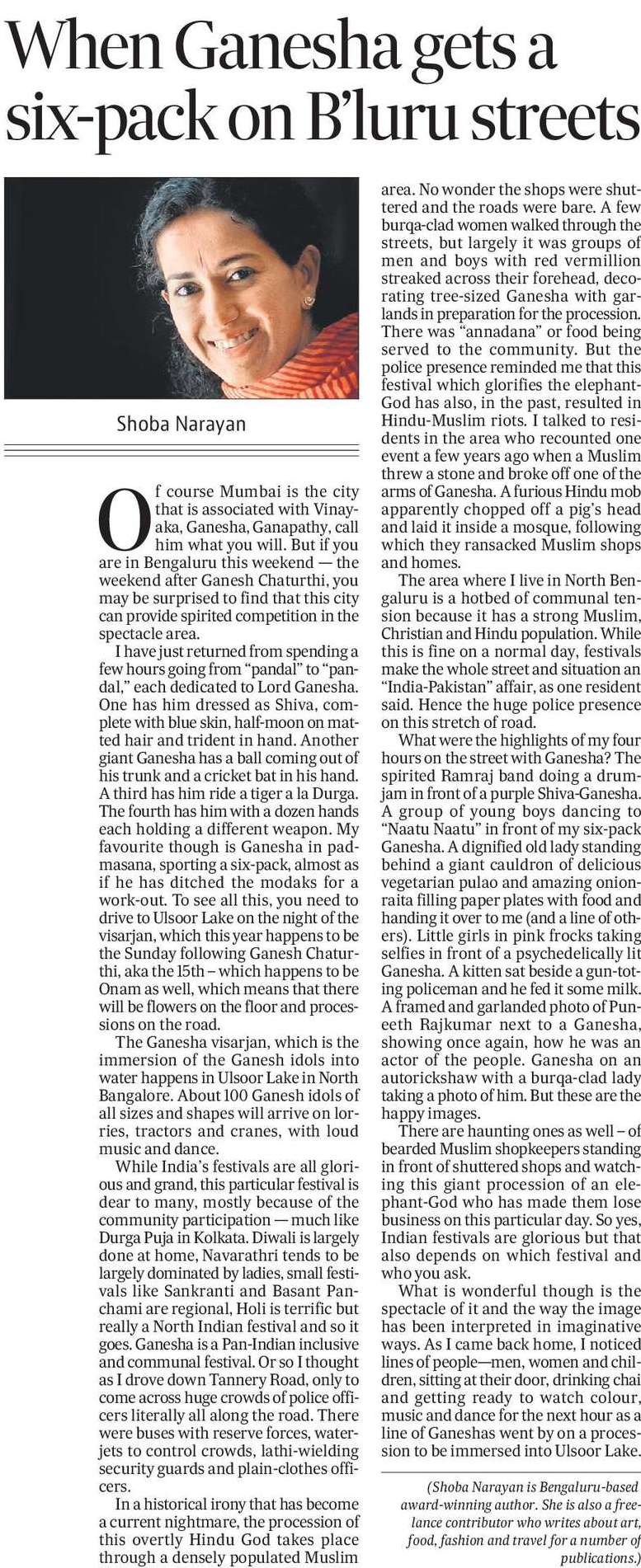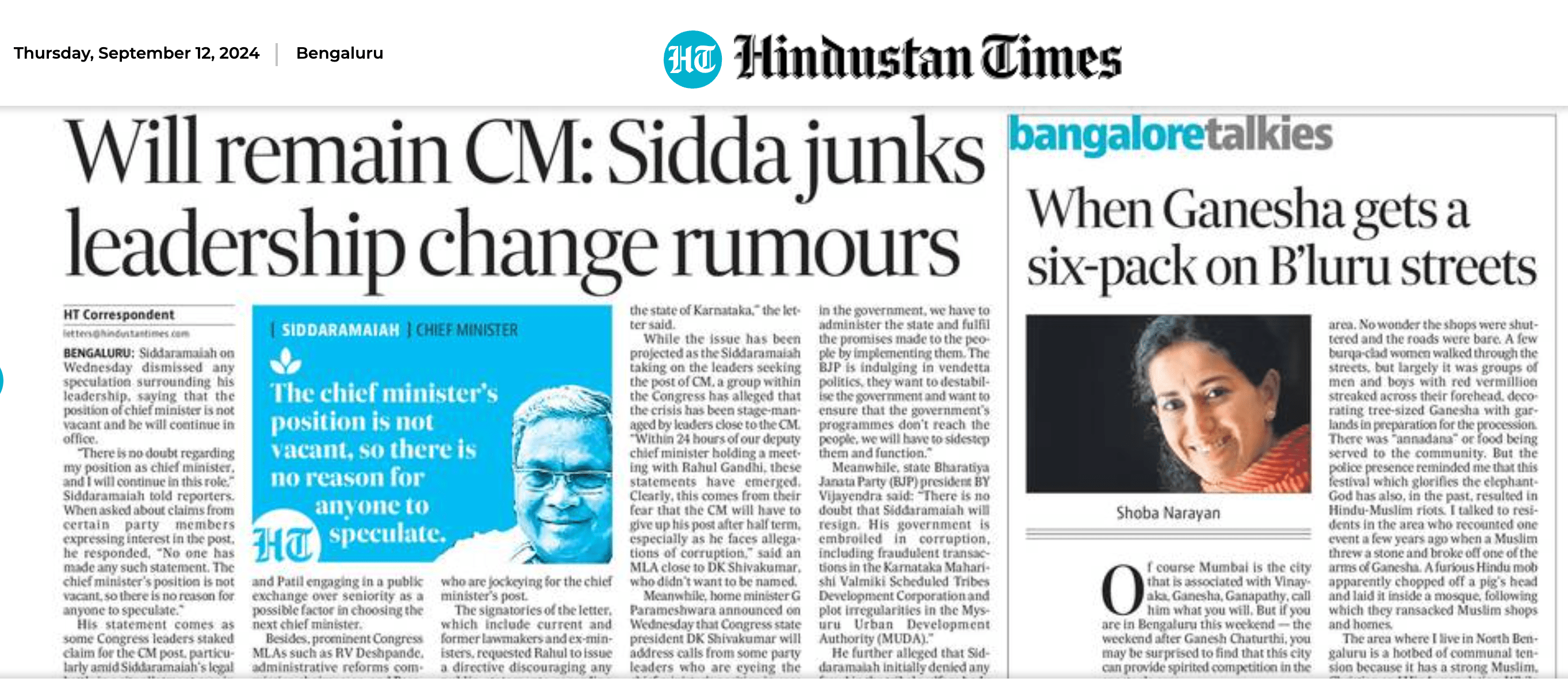Of course Mumbai is the city that is associated with Vinayaka, Ganesha, Ganapathy, call him what you will. But if you are in Bangalore this weekend– the weekend after Ganesh Chaturthi, you may be surprised to find that this city can provide spirited competition in the spectacle area.
I have just returned from spending a few hours going from “pandal” to “pandal,” each dedicated to Lord Ganesha. One has him dressed as Shiva, complete with blue skin, half-moon on matted hair and trident in hand. Another giant Ganesha has a ball coming out of his trunk and a cricket bat in his hand. A third has him ride a tiger a la Durga. The fourth has him with a dozen hands each holding a different weapon. My favourite though is Ganesha in padmasana, sporting a six-pack, almost as if he has ditched the modaks for a work-out. To see all this, you need to drive to Ulsoor Lake on the night of the visarjan, which this year happens to be the Sunday following Ganesh Chaturthi, aka the 15th – which happens to be Onam as well, which means that there will be flowers on the floor and processions on the road.
The Ganesha visarjan, which is the immersion of the Ganesh idols into water happens in Ulsoor Lake in North Bangalore. About 100 Ganesh idols of all sizes and shapes will arrive on lorries, tractors and cranes, with loud music and dance. While India’s festivals are all glorious and grand, this particular festival is dear to many, mostly because of the community participation — much like Durga Puja in Kolkata. Diwali is largely done at home, Navarathri tends to be largely dominated by ladies, small festivals like Sankranti and Basant Panchami are regional, Holi is terrific but really a North Indian festival and so it goes. Ganesha somehow is a Pan-Indian inclusive and communal festival. Or so I thought as I drove down Tannery Road, only to come across huge crowds of police officers literally all along the road. There were buses with reserve forces, waterjets to control crowds, lathi-wielding security guards and plain-clothes officers. In a historical irony that has become a current nightmare, the procession of this overtly Hindu God takes place through a densely populated Muslim area. No wonder the shops were shuttered and the roads were bare. A few burqa-clad women walked through the streets, but largely it was groups of men and boys with red vermillion streaked across their forehead, decorating tree-sized Ganesha with garlands in preparation for the procession. There was “annadana” or food being served to the community. But the police presence reminded me that this festival which glorifies the elephant-God has also, in the past, resulted in Hindu-Muslim riots. I talked to residents in the area who recounted one event a few years ago when a Muslim threw a stone and broke off one of the arms of Ganesha. A furious Hindu mob apparently chopped off a pig’s head and laid it inside a mosque, following which they ransacked Muslim shops and homes.
The area where I live in North Bangalore is a hotbed of communal tension because it has a strong Muslim, Christian and Hindu population. While this is fine on a normal day, festivals make the whole street and situation an “India-Pakistan” affair, as one resident said. Hence the huge police presence on this stretch of road.
What were the highlights of my four hours on the street with Ganesha? The spirited Ramraj band doing a drum-jam in front of a purple Shiva-Ganesha. A group of young boys dancing to “Naatu Naatu” in front of my six-pack Ganesha. A dignified old lady standing behind a giant cauldron of delicious vegetarian pulao and amazing onion-raita filling paper plates with food and handing over to me (and a line of others). Little girls in pink frocks taking selfies in front of a psychedelically lit Ganesha. A kitten sat beside a gun-toting policeman and he fed it some milk. A framed and garlanded photo of Puneeth Rajkumar next to a Ganesha, showing once again, how he was an actor of the people. Ganesha on an autorickshaw with a burqa-clad lady taking a photo of him. But these are the happy images. There are haunting ones as well – of bearded Muslim shopkeepers standing in front of shuttered shops and watching this giant procession of an elephant-God who has made them lose business on this particular day. So yes, Indian festivals are glorious but that also depends on which festival and who you ask.
What is wonderful though is the spectacle of it and the way the image has been interpreted in imaginative ways. As I came back home, I noticed lines of people—men, women and children, sitting at their door, drinking chai and getting ready to watch colour, music and dance for the next hour as a line of Ganeshas went by on a procession to be immersed into Ulsoor Lake.
Shoba Narayan is Bangalore-based award-winning author. She is also a freelance contributor who writes about art, food, fashion and travel for a number of publications.



-k4lD-U204025897261YmH-250x250%40HT-Web.jpg)



Leave A Comment